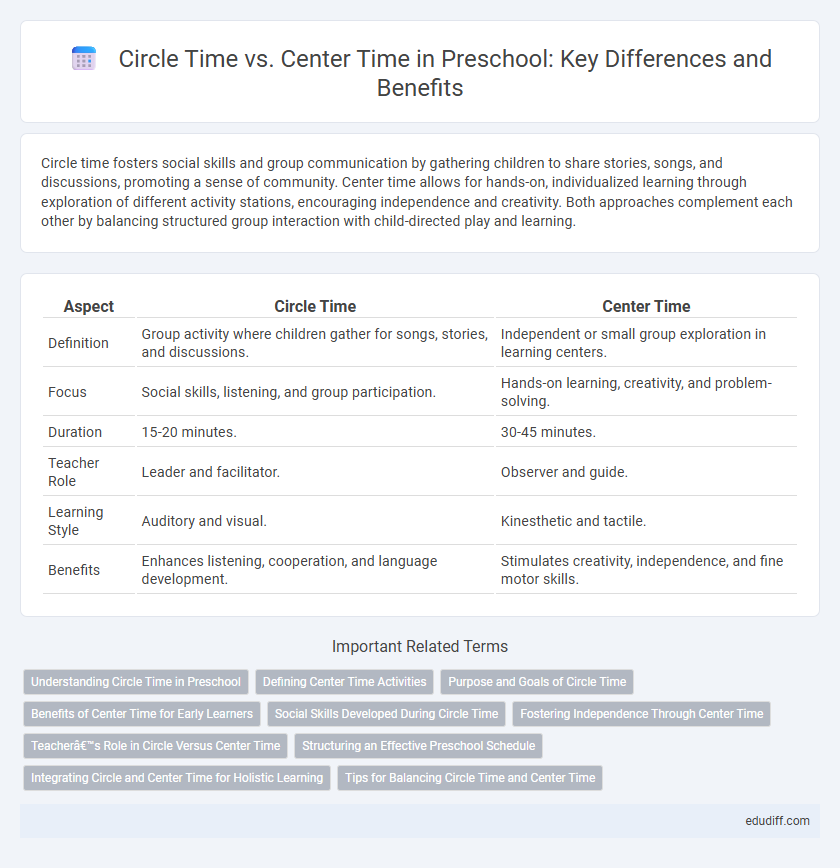Circle time fosters social skills and group communication by gathering children to share stories, songs, and discussions, promoting a sense of community. Center time allows for hands-on, individualized learning through exploration of different activity stations, encouraging independence and creativity. Both approaches complement each other by balancing structured group interaction with child-directed play and learning.
Table of Comparison
| Aspect | Circle Time | Center Time |
|---|---|---|
| Definition | Group activity where children gather for songs, stories, and discussions. | Independent or small group exploration in learning centers. |
| Focus | Social skills, listening, and group participation. | Hands-on learning, creativity, and problem-solving. |
| Duration | 15-20 minutes. | 30-45 minutes. |
| Teacher Role | Leader and facilitator. | Observer and guide. |
| Learning Style | Auditory and visual. | Kinesthetic and tactile. |
| Benefits | Enhances listening, cooperation, and language development. | Stimulates creativity, independence, and fine motor skills. |
Understanding Circle Time in Preschool
Circle Time in preschool serves as a structured group activity designed to develop children's social skills, attention span, and language abilities through interactive songs, stories, and discussions. This focused time allows educators to introduce new concepts, reinforce classroom routines, and build a sense of community among young learners. Understanding Circle Time's role is essential for promoting early cognitive development and emotional regulation before transitioning to the more exploratory, hands-on learning of Center Time.
Defining Center Time Activities
Center time activities in preschool are focused, hands-on learning experiences located in designated areas such as art, math, reading, and sensory tables. These activities promote independent exploration, creativity, and skill development through play, allowing children to engage with materials at their own pace. Center time supports differentiated instruction by accommodating various learning styles and fostering social interaction among peers.
Purpose and Goals of Circle Time
Circle time in preschool centers on fostering social-emotional skills, promoting group communication, and establishing classroom routines. Its primary purpose is to build a sense of community, encourage turn-taking, and support language development through shared activities and discussions. Unlike Center time, which emphasizes individual exploration and hands-on learning, Circle time aims to unify children in collaborative learning experiences.
Benefits of Center Time for Early Learners
Center time enhances early learners' development by promoting hands-on exploration and fostering independence in a child-centered environment. It encourages social skills through small-group interactions and supports cognitive growth by allowing children to engage with varied materials that match their interests. This approach boosts creativity, problem-solving abilities, and self-regulation, essential for foundational learning.
Social Skills Developed During Circle Time
Circle time in preschool fosters essential social skills such as active listening, turn-taking, and group collaboration, which are fundamental for effective communication and peer interaction. This structured group activity encourages children to express their thoughts, recognize others' perspectives, and develop empathy within a supportive environment. In contrast, center time emphasizes independent play and exploration, offering opportunities for problem-solving but less direct social engagement.
Fostering Independence Through Center Time
Center time in preschool environments fosters independence by allowing children to choose activities that match their interests and developmental levels, promoting decision-making skills. Unlike circle time, which is teacher-directed and group-focused, center time encourages self-regulation and problem-solving as children explore materials and interact with peers. This structured free play supports autonomy and confidence essential for early childhood development.
Teacher’s Role in Circle Versus Center Time
During circle time, the teacher leads structured group interactions, guiding discussions, introducing new concepts, and fostering social skills through active engagement. In center time, the teacher assumes a facilitative role by observing, supporting individual exploration, and providing personalized assistance to promote independent learning. This shift from directive teaching in circle time to responsive support in center time enhances children's cognitive and social development in preschool settings.
Structuring an Effective Preschool Schedule
Circle time fosters group interaction and language development through structured activities like songs, storytelling, and discussions, promoting social skills and attention span in preschoolers. Center time allows children to explore hands-on learning stations independently or in small groups, enhancing creativity, problem-solving, and fine motor skills. Balancing circle time with center time creates a dynamic preschool schedule that supports diverse learning styles and maximizes developmental outcomes.
Integrating Circle and Center Time for Holistic Learning
Integrating circle time and center time enhances preschoolers' holistic learning by combining group interaction with hands-on activities that develop social, cognitive, and motor skills. Circle time fosters language development and collaboration through songs, stories, and discussions, while center time encourages independent exploration and problem-solving in specialized learning areas. Balancing these two formats ensures a dynamic learning environment that meets diverse developmental needs and promotes comprehensive early childhood growth.
Tips for Balancing Circle Time and Center Time
Balancing circle time and center time in preschool requires scheduling shorter, engaging circle sessions to maintain children's attention and maximize group learning. Incorporate hands-on activities during circle time to connect with center-based play themes, reinforcing concepts across both formats. Monitor children's responses to adjust the duration and structure, ensuring active participation and seamless transitions between whole-group instruction and individualized exploration.
Circle time vs Center time Infographic

 edudiff.com
edudiff.com